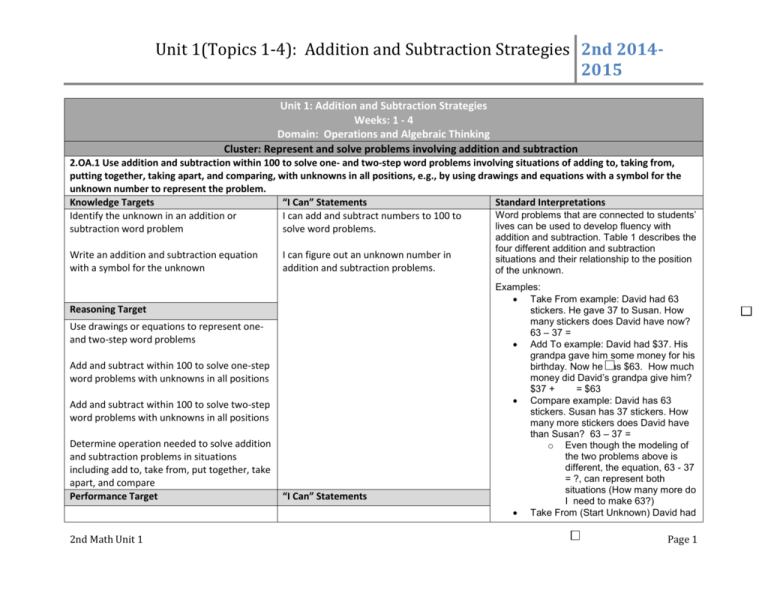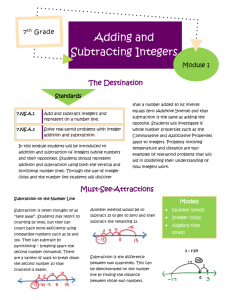Unit 1(Topics 1-4): Addition and Subtraction Strategies
advertisement

Unit 1(Topics 1-4): Addition and Subtraction Strategies 2nd 20142015 Unit 1: Addition and Subtraction Strategies Weeks: 1 - 4 Domain: Operations and Algebraic Thinking Cluster: Represent and solve problems involving addition and subtraction 2.OA.1 Use addition and subtraction within 100 to solve one- and two-step word problems involving situations of adding to, taking from, putting together, taking apart, and comparing, with unknowns in all positions, e.g., by using drawings and equations with a symbol for the unknown number to represent the problem. Knowledge Targets “I Can” Statements Standard Interpretations Word problems that are connected to students’ Identify the unknown in an addition or I can add and subtract numbers to 100 to lives can be used to develop fluency with subtraction word problem solve word problems. Write an addition and subtraction equation with a symbol for the unknown I can figure out an unknown number in addition and subtraction problems. Reasoning Target Use drawings or equations to represent oneand two-step word problems Add and subtract within 100 to solve one-step word problems with unknowns in all positions Add and subtract within 100 to solve two-step word problems with unknowns in all positions Determine operation needed to solve addition and subtraction problems in situations including add to, take from, put together, take apart, and compare Performance Target 2nd Math Unit 1 “I Can” Statements addition and subtraction. Table 1 describes the four different addition and subtraction situations and their relationship to the position of the unknown. Examples: Take From example: David had 63 stickers. He gave 37 to Susan. How many stickers does David have now? 63 – 37 = Add To example: David had $37. His grandpa gave him some money for his birthday. Now he has $63. How much money did David’s grandpa give him? $37 + = $63 Compare example: David has 63 stickers. Susan has 37 stickers. How many more stickers does David have than Susan? 63 – 37 = o Even though the modeling of the two problems above is different, the equation, 63 - 37 = ?, can represent both situations (How many more do I need to make 63?) Take From (Start Unknown) David had Page 1 Unit 1(Topics 1-4): Addition and Subtraction Strategies 2nd 20142015 some stickers. He gave 37 to Susan. Now he has 26 stickers. How many stickers did David have before? 37 = 26 It is important to attend to the difficulty level of the problem situations in relation to the position of the unknown. Result Unknown, Total Unknown, and Both Addends Unknown problems are the least complex for students. The next level of difficulty includes Change Unknown, Addend Unknown, and Difference Unknown The most difficult are Start Unknown and versions of Bigger and Smaller Unknown (compare problems). Second graders should work on ALL problem types regardless of the level of difficulty. Mastery is expected in second grade. Students can use interactive whiteboard or document camera to demonstrate and justify their thinking. This standard focuses on developing an algebraic representation of a word problem through addition and subtraction --the intent is not to introduce traditional algorithms or rules. Make sense of problems and preserver in solving them. 2nd Math Unit 1 Reason abstractly and quantitatively Construct viable arguments and critiques the reasoning of others Model with mathematics Use appropriate tools strategically Attend to precision Look for and make use of structure Look for and express regularity in repeated reasoning Page 2 Unit 1(Topics 1-4): Addition and Subtraction Strategies 2nd 20142015 Cluster: Add and Subtract Within 20 2.OA.2 Fluently add and subtract within 20 using mental strategies.2 By end of Grade 2, know from memory all sums of two one-digit numbers. Knowledge Targets “I Can” Statements Standard Interpretations This standard is strongly connected to all the I can fluently add and subtract to 20 using Know mental strategies for addition and standards in this domain. It focuses on mental math strategies. subtraction students being able to fluently add and subtract numbers to 20. Adding and subtracting fluently refers to knowledge of procedures, knowledge of when and how to use them appropriately, and skill in performing them flexibly, accurately, and efficiently. Know from memory all sums of two one-digit numbers Mental strategies help students make sense of number relationships as they are adding and subtracting within 20. The ability to calculate mentally with efficiency is very important for all students. Mental strategies may include the following: Counting on Making tens (9 + 7 = 10 + 6) Decomposing a number leading to a ten ( 14 – 6 = 14 – 4 – 2 = 10 – 2 = 8) Fact families (8 + 5 = 13 is the same as 13 - 8 = 5) Doubles Doubles plus one (7 + 8 = 7 + 7 + 1) Reasoning Targets Apply mental strategies to add and subtract fluently within 20. However, the use of objects, diagrams, or interactive whiteboards, and various strategies will help students develop fluency. Make sense of problems and preserver in solving them. 2nd Math Unit 1 Reason abstractly and quantitatively Construct viable arguments and critiques the reasoning of others Model with mathematics Use appropriate tools strategically Attend to precision Look for and make use of structure Look for and express regularity in repeated reasoning Page 3 Unit 1(Topics 1-4): Addition and Subtraction Strategies 2nd 20142015 Cluster: Work with equal groups of objects to gain foundations for multiplication. 2.OA.4 Use addition to find the total number of objects arranged in rectangular arrays with up to 5 rows and up to 5 columns; write an equation to express the total as a sum of equal addends. Knowledge Targets “I Can” Statements Standard Interpretations Write an equation with repeated equal I can use addition to tell how many objects are Students may arrange any set of objects into a rectangular array. Objects can be cubes, addends from an array. in an array and I can write an equation to buttons, counters, etc. Objects do not have to show it. I can arrange objects into a rectangular array. be square to make an array. Geoboards can also be used to demonstrate rectangular arrays. Students then write equations that represent the total as the sum of equal addends as shown below. Reasoning Target Generalize the fact that arrays can be written as repeated addition problems. 4 + 4 + 4 = 12 Solve repeated addition problems to find the number of objects using rectangular arrays. Performance Target Make sense of problems and preserver in solving them. 2nd Math Unit 1 Reason abstractly and quantitatively Construct viable arguments and critiques the reasoning of others 5 + 5 + 5 + 5 = 20 Interactive whiteboards and document cameras may be used to help students visualize and create arrays. Model with mathematics Use appropriate tools strategically Attend to precision Look for and make use of structure Look for and express regularity in repeated reasoning Page 4 Unit 1(Topics 1-4): Addition and Subtraction Strategies 2nd 20142015 Vocabulary Topic 1 Part Whole Add Sum Addition Sentence Plus (+) Equals (=) Join Subtract Difference Subtraction Sentence Minus (-) Separate More Fewer Related Fact Family 2nd Math Unit 1 Topic 2 Doubles Near Doubles Addend Number Sentence Topic 3 Topic 4 Array Page 5








